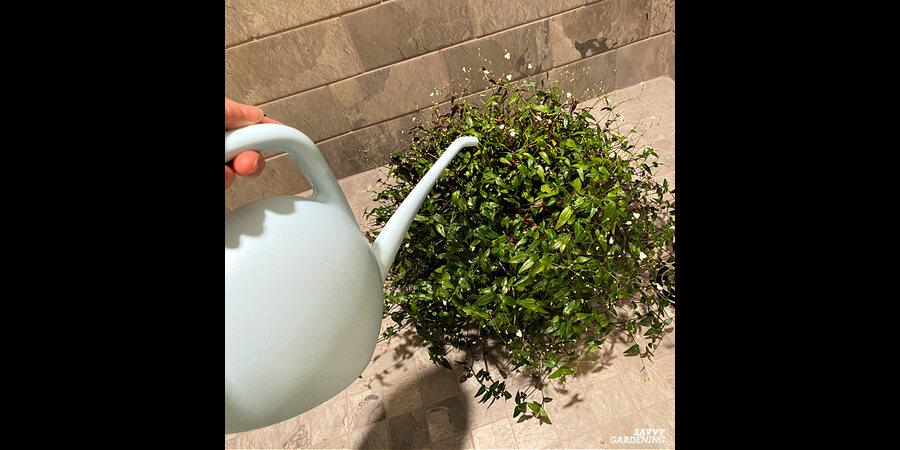1. Introducing the Bridal Veil Plant
The Bridal Veil Plant (Gibasis pellucida), also known as the Tahitian Bridal Veil, is a
stunning plant admired for its cascading foliage and delicate beauty. Its dark green
leaves, with subtle hints of purple on the undersides, create a striking contrast, while its
slender purple stems enhance its dramatic trailing effect.Your Ultimate Guide to Growing
Native to tropical regions of Central and South America, this plant flourishes in warm
environments. One of its most enchanting features is its dainty, white, three-petaled
flowers, which bloom throughout the year, adding a soft elegance to its appearance.
Beyond its visual appeal, these blossoms carry a subtle, sweet fragrance, making the
Bridal Veil Plant a unique centerpiece in any indoor garden.
2. Creating the Ideal Environment
To ensure your Bridal Veil Plant thrives, you’ll need to create an environment that
mimics its natural tropical habitat.
Light: This plant flourishes in bright, indirect sunlight. While it can tolerate
some direct sunlight, too much exposure can scorch its tender leaves. Place it
near a window with filtered light or in a shaded sunroom for the best results.
Temperature: The ideal range is between 55°F and 70°F (13°C – 21°C).
Keeping it within this range ensures its colors stay rich and vibrant, preventing
stress that could hinder growth.
Soil: A well-draining soil is essential for success. A blend of organic matter,
including coco coir, perlite, and vermiculite, promotes drainage and aeration,
creating a gritty, nutrient-rich mix that prevents water from lingering around
the roots. This reduces the risk of root rot, making a strong drainage system the
cornerstone of healthy plant growth.

3. Watering and Nutrient Management
Mastering the art of watering and feeding is key to caring for your Bridal Veil Plant.
Watering Routine: Avoid overwatering, which is a common pitfall. This plant
prefers its soil to dry slightly between waterings. A good rule of thumb is to
check the top inch of soil—if it feels dry, it’s time to water.
Seasonal Adjustments:
o In warmer months (spring and summer), when the plant is in its active
growing stage, watering once or twice a week is usually sufficient.
o During cooler months, the watering frequency should be reduced to
prevent excess moisture buildup. It’s better to err on the side of
underwatering rather than risk saturating the roots and causing root rot.
Fertilizing: The Bridal Veil Plant is a light feeder. A monthly application of a
balanced, water-soluble fertilizer during the spring and summer will helpmaintain its vigor and encourage a healthy bloom cycle. For a low-
maintenance approach, you can use an organic, slow-release fertilizer, which
minimizes the risk of burning and supports steady growth. Be cautious of
over-fertilization—a modest dose is all that’s necessary to keep this plant
flourishing.
4. Propagation: Growing More from a Single Plant
One of the most gratifying experiences in plant care is propagating your Bridal Veil
Plant. This allows you to expand your indoor garden with easeYour Ultimate Guide to Growing.
Method: Propagation is best done using healthy stem cuttings. Select a vigorous,
trailing section of the plant and trim it uses sharp, clean scissors.
Preparing the Cutting: Remove the lower leaves to expose the nodes, as these
are the sites where roots will develop.
Rooting Options:
o Water Method: Place the cutting in a clean jar of water, ensuring that
only the nodes remain submerged, while the rest of the stem stays above
the waterline. Change the water weekly to keep it fresh. Within a week,
you should see robust roots forming.
o Soil Method: Alternatively, you can dip the cut end in rooting hormone
and plant it directly in a pot filled with moist, well-draining soil. Once a
healthy root system develops, transplant it into a larger container for
continued growth.
Watching new life develop from a simple cutting is an incredibly rewarding experience!
5. Pruning and Repotting for Optimal Growth
Keeping your Bridal Veil Plant in top shape requires regular pruning and repotting.
Pruning:
o Trim dead or overextended stems during the spring and summer, the
plant’s active growing seasons.Your Ultimate Guide to Growing
o This not only tidies its appearance but also encourages denser, bushier
growth, leading to prolific blooming.
o A periodic trim helps the plant redirect its energy toward new, vigorous
growth while sustaining older branches.
Repotting:o If you notice roots emerging from the drainage holes, it’s time to repot.
o Choose a container with adequate drainage and refresh the soil with a
nutrient-rich, well-draining mix.
o Ensure the plant is placed at the same depth as before and gently work
new soil around the roots to eliminate air pockets.

6. Troubleshooting Common Issues
Even with the best care, some challenges may arise.
Root Rot: Often caused by overwatering or poor drainage, this issue presents
as darkened, mushy roots and yellowing leaves. Adjust your watering schedule
and repot the plant in fresh, well-draining soil if necessary.
Pest Infestations: Watch out for spider mites, aphids, and mealybugs. Treat
infestations with insecticidal soap or a gentle water spray, ensuring you inspect
under the leaves for early signs.
Pet Safety: The Bridal Veil Plant is non-toxic to cats and dogs, but accidental
ingestion may cause mild contact dermatitis. Keep it out of reach to prevent
issues.
7. Bringing Your Personal Touch to the Process
Gardening is both an art and a science, and caring for a Bridal Veil Plant is a creative
and rewarding process. Each plant responds uniquely to its environment, andunderstanding its subtle cues—such as leaf color changes and flowering patterns—
deepens your experience.
Your care routine will evolve as you observe and adjust based on light levels, humidity,
and soil conditions. This dynamic relationship makes plant care a truly personal
journey.

8. Final Thoughts: Embracing the Beauty of Nature
Growing a Bridal Veil Plant is a journey of learning and discovery. Selecting the right
spot with indirect sunlight, mastering the balance of watering,Your Ultimate Guide to Growing and understanding its
soil needs are essential steps toward success.
Whether you’re a seasoned gardener or just starting out, this charming, low-
maintenance plant will reward you with exquisite blooms and lush, trailing foliage.
With patience and care, your indoor oasis will flourish, bringing a touch of ethereal
beauty into your home.


Pingback: The Ultimate Guide to Growing an Elephant Ear Plant Indoors - choosewise.info